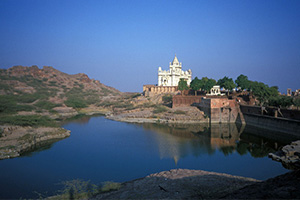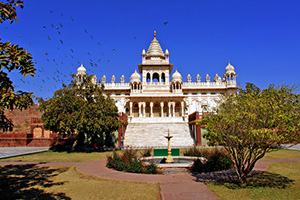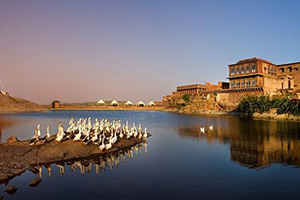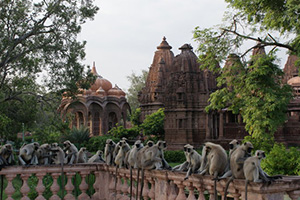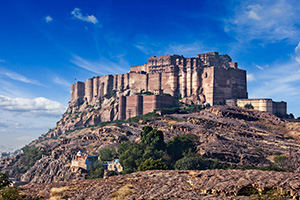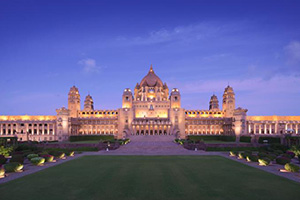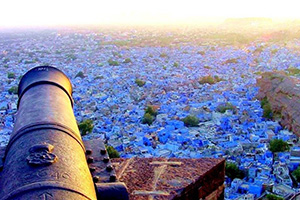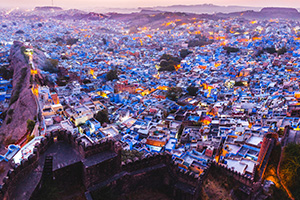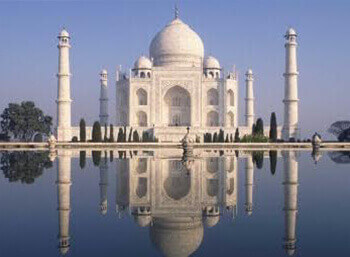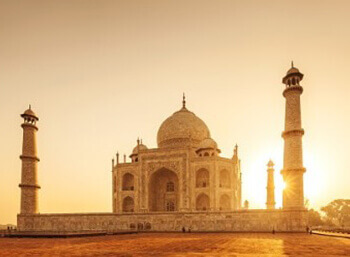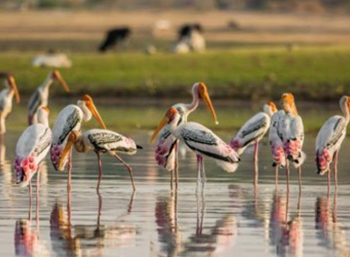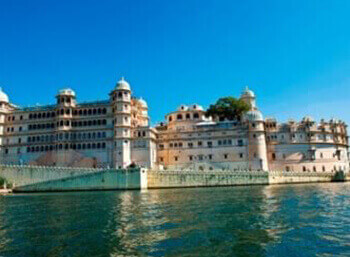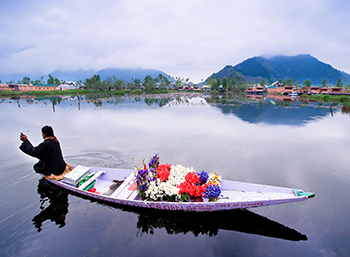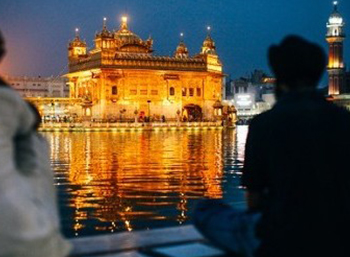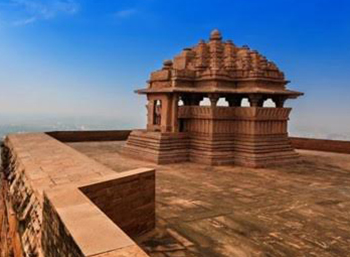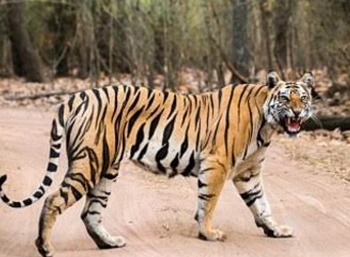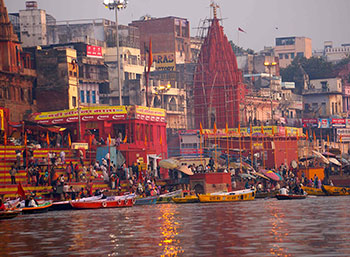Tourism In Rajasthan
Jodhpur
Jodhpur history revolves around the Rathore Clan. Rao Jodha, the chief of the Rathore clan, is credited with the origin of Jodhpur in India. He founded Jodhpur in 1459. The city is named after him only. It was previously known as Marwar. The following paragraphs will tell you more about the past of Jodhpur, Rajasthan.
The Rathores were driven out of their original homeland, Kaunaj, by Afghans. They fled to Pali, near to the present day Jodhpur. Rathore Siahaji married the sister of a local prince. This helped the Rathores to establish and strengthen themselves in this region. In some time they ousted the Pratiharas of Mandore, just 9 km of today's Jodhpur. Initially, Mandore served as their capital, but, by 1459, Rathores felt a need for a secure capital. This lead to the formation of Jodhpur, the Sun City, by Rao Jodha.
The Rathores enjoyed good relations with all the Mughals, except Aurangzeb. Maharaja Jaswant Singh even supported Shahjahan in his struggle for succession. After Aurangzeb's death, Maharaja Ajit Singh drove out Mughals from Ajmer and added it to Marwar (now Jodhpur). Under the reign of Maharaja Umed Singh, Jodhpur grew into a fine modern city.
During the British Raj, the state of Jodhpur was the largest in Rajputana, by land area. Jodhpur prospered under the British Raj. Its merchants, the Marwaris, flourished endlessly. They came to occupy a dominant position in trade throughout India. In 1947 India became independent and the state merged into the union of India. Jodhpur became the second city of Rajasthan.
Famous Tourist Attractions :
Mehrangarh Fort
Mehrangarh Fort tops the list of ‘must visit’ places in Jodhpur. It is one among the largest Indian forts. This invincible fort stands magnificently 400 feet above the city. Rao Jodha constructed the fort in 1459 AD. Though the attempt to construct the fort was started in 1459, the fort had seen many centuries before it was completed. Hence, you could find that the style of architecture represents various periods. The grandeur in architecture is awe-inspiring. It offers stunning views of the city. The fort stands as a symbol of power.
Jaswant Thada
Jaswant Thada was built in memory of Maharaja Jaswant Singh, the Second in the year 1899. This is close to Mehrangarh Fort. The tranquility of the marble construction is enchanting. The carvings are intricate. Inside Jaswant Thada, you will find the portraits of the Rathore rulers. The grounds of Jaswant Thada consist of a stunning multilevel garden, intricately carved gazebos and a pond.
Balsamand Lake
Balsamand Lake is an artificial lake that was constructed by Balak Rao Parihar in 1159 AD. The lush greenery around the lake has mango groves, papaya groves and groves of guava, plum and pomegranate. Balsamand Lake Palace was intended to serve as summer resort for the royal family of Jodhpur. The lawns and gardens with birds and peacocks finding their homes here, the place is exquisite. The palace reflects Rajputana style of architecture. The palace turned heritage hotel was built of red sandstone.
Kailana Lake
Kailana Lake is located on west of the city. This is yet another artificial lake, which was constructed in the year 1872 by Pratap Singh. This is one amongst the most frequented lakes in Rajasthan. It is a birdwatchers’ paradise. You could sail on a boat if you aim to add some breathtaking photographs to your collection. The view of sunset would be stunning.
Rao Jodha Desert Rock Park
The aim behind the formation of Rao Jodha Desert Rock Park in the year 2006 was to restore the rocky area near the fort. Once preliminary steps were taken to restore the land, more than 80 native plant species from the famous Thar Desert were grown. The 200 acres of park is located at the foot of the impregnable Mehrangarh Fort. The place reflects the hard work and dedication of the ecologists who spared no efforts to make the place green.
Umaid Bhawan Palace Museum
The construction of Umaid Bhawan Palace Museum was started in the year 1929 and it was completed in 1943. The palace is situated on the highest point in the city. The 347-roomed massive palace is named one of the largest private residences in the world. The palace boasts of a combination of Indian and European style of architecture. A part of the palace still serves as a residence to the former royal family, while other two parts of the palace are converted into Taj Palace Hotel and museum.
Mandore Gardens
Mandore, belonging to the 6th century, was Marwar’s capital before Jodhpur was established. Mandore Gardens here attract tourists in great numbers. The Mandore Gardens also house a government museum, a ‘Hall of Heroes’ and a temple to 33 crore Gods. Various artifacts and statues found in the area are housed at the museum. The architectural splendor of the bygone era is clearly evident here.
Mandore Gardens
Clock Tower is a famous landmark in the Old City. It was constructed by Maharaja Sardar Singh during his tenure between 1880 and 1911. The clock tower offers a good view of the fort. Sardar Market is adjacent to Clock Tower where a wide range of products is sold. You can find handicrafts, saris, spices, vegetables and a lot more. There are over 7000 shops and you can have a great shopping experience here.
Famously called the ‘Sun City’ and the ‘Blue City’, tourist places in Jodhpur brings back the days of the past. If you are passionate about things of the past, you will love the city that is rich in palaces, forts and museums. You could indulge yourself in a great purchasing spree as the city offers unique handicrafts, antiques, miniature elephants, silver jewelry and many more.
How To Reach
In the following paragraphs, we have provided information about the modes of transportation to Jodhpur, Rajasthan. Jodhpur, India travel is quite easy and accessible. Read on to know "How to reach Jodhpur":
By Air
The Jodhpur Airport is 5 km from the city center. Regular flight services connect the city with other major cities in and around Rajasthan. There are daily flights to Delhi, Mumbai, Udaipur and Jaipur.
By Train
Jodhpur is well connected by railway lines. Trains to Delhi, Mumbai, Chennai and Kolkata are easily available. The 'Palace on Wheels' also visits this city of royal splendor.
By Road
Another convenient mode of transportation to Jodhpur is by road. The main highway between Jodhpur and Jaisalmer is via Agoli and Pokaran. The highway is well connected with Agra, Ahmedabad, Ajmer, Delhi, Jaipur, Jaisalmer and Udaipur by bus.
Local Transport
Means of transport in Jodhpur include Taxis, Auto-rickshaws and Tongas. Taxi stand is near the main railway station. Auto-rickshaws are best suited for the narrow lanes of the old city. You can also explore Jodhpur with a bicycle..
